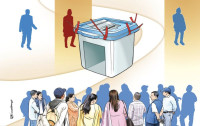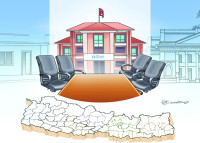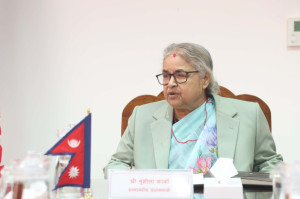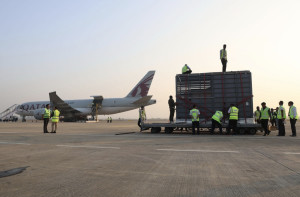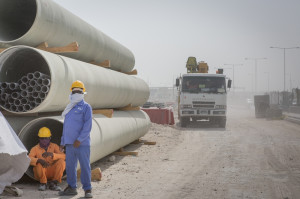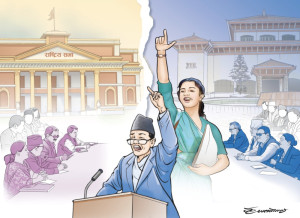Columns
Needed: A prudent monetary policy
But it will not be able to singlehandedly address the deep-rooted structural problem of the economy.
Nishant Khanal
With Nepal facing a tricky economic scenario of late, all eyes are on the upcoming monetary policy. Stakeholders beyond banks and financial institutions, including the private sector and even the finance minister Prakash Sharan Mahat, hope that the central bank’s monetary policy for the fiscal year 2023-24 is a one-shot solution to the current economic contraction. The external sector indicators published by the central bank based on the 11 months of the last fiscal year displayed significant improvements in the key indicators.
The macroeconomic review revealed a surplus balance of payments, a 25-percent increase in the forex reserve. Similarly, ratios of reserves-to-GDP, reserves-to-imports and reserves-to-M2 also demonstrated improvement compared to the previous year. Despite these positive economic indicators, the market, including businesses and households, struggles to survive. Banks and financial institutions now have excess liquidity than earlier, resulting in the increased cost of funds. The credit growth is not as expected, leading banks to eliminate cartels in the interest rates, at least for the upcoming quarter.
The finance minister has signalled some structural changes in the economy through current fiscal policy, but the leadership doesn't appear confident that these changes will drive the economy smoothly. Notably, revenue collection, which had been increasing each fiscal year, dropped for the first time in 55 years, and managing public finance is increasingly becoming challenging for the government. There is a need for a 48-percent growth in revenue to achieve the economic growth target set by the fiscal policy, which seems impossible. The ball has been passed to the central bank, and the stakeholders hope the monetary policy will help them maintain business as usual. However, the question remains: Is monetary policy the right instrument to tackle this economic contraction? Are there any rooms for the fiscal and monetary tools to align and collectively address the present challenges?
A misguided approach
Amid the Covid-19 pandemic, the central bank supported the commercial banks in expanding their banking business. An expansionary monetary policy, with the reduction in bank rates and reserve requirements, refinancing and concessional facilities, helped commercial banks inject an additional Rs800 billion in loans while many other businesses were struggling to survive. Unfortunately, most loans were distributed in unproductive and short-term lending, such as margin lending and real estate, resulting in increased profit earned by the commercial banks. The generosity of the central bank during the crisis was proven to be a wrong move in the economy. Despite the corrections from the subsequent monetary policies and the provisions, the economy is still suffering from the aftermath of the 2020 monetary policy.
Past lessons
Given the earlier experience of the central bank rescuing the economy, there are some obvious expectations from the upcoming monetary policy. Stakeholders might hope for another round of central bank intervention to support profitability. But it is essential to realise that two wrong policies will not result in the right solution. Expectations should be tempered, and there should be an acknowledgement that monetary policy alone is not the ultimate solution to the current economic challenges.
The financial sector indicators from June 2023 present a complex situation. The deposit-to-GDP ratio stands at 103.48 percent, highlighting a substantial deposit base compared to the economy. However, credit expansion is not keeping pace with the overall economic output, as the credit/GDP ratio is 90.28 percent. In addition, the credit-to-deposit ratio is at 87.24 percent, signalling liquidity overflow in commercial banks. This is a recurring scenario in Nepal’s financial sector. The central bank should promote financial stability and ensure a sustainable credit environment to align with the fiscal policy and achieve the targeted growth of 6 percent. A few measures could help untangle the current economic intricacies, such as imposing sector-based credit restrictions, particularly on the unproductive sectors.
As the figures for non-performing loans and blacklisted creditors have increased significantly, the upcoming monetary policy must emphasise implementing credit quality enhancement. The adjustment of the policy rates must be targeted rather than keeping a broad rate. Careful use of counter-cyclical buffer instruments would help the central bank maintain the financial sector stability in the long run, but the market might not welcome it.
Beyond monetary policy
While essential in influencing liquidity and interest rate, monetary policy won’t singlehandedly address the deep-rooted structural problem of the economy as expected by many. Rather than passing the ball, the economic actors should acknowledge the challenges and find a ground to address these challenges beyond the monetary policy collectively.
Due to reduced aggregate demand in the market, squeezed import has increased the forex reserve. This situation is unsustainable, as the output and production in the economy are low, jobs are scarce and consumer prices are increasing, resulting in lower market demand. On the other hand, fiscal policy has become needlessly expansionary without resources, creating pressure in both the micro- and macro-economic environment. With all these demand and supply side shocks, the Philips curve, which shows the relationship between inflation, unemployment and growth, is now inverted in Nepal. And this has led to a situation of “stagflation”. Since the fiscal policy is already in place and doesn’t address economic challenges, flexibility in monetary policy alone will not resolve the crisis.
A collective and serious effort towards structural reform is needed to tackle stagflation. This includes revision on the pegged rate, targeted stimulus through fiscal policy, productivity-enhancing reforms including on infrastructures and technology, and supply side policy reforms. These must align with a prudent monetary policy to effectively rescue the economy. Otherwise, we’ll be trapped in the vicious cycle of stagflation.




 5.14°C Kathmandu
5.14°C Kathmandu


